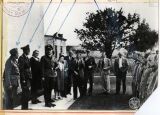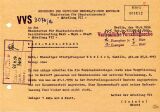back...Torturer of Polish children - a Stasi agent
The hitherto unknown circumstances of the collaboration with the Communist security forces of Camillo Ehrlich, former commandant of the German Nazi Concentration Camp for Polish Children on Przemysłowa Street in Łódź, never accounted for the crimes he committed, were the leading topic of a press conference organised by the Museum of Polish Children – victims of totalitarianism.
The historians at the Museum of Polish Children – victims of totalitarianism in Łódź have reached completely unknown facts about the post-war fate of Camillo Ehrlich, former commandant of the camp for Polish children on Przemysłowa Street.
“In the archival materials of the Dresden branch of the Stasi Archives, there is a commitment by Camillo Ehrlich to cooperate with East German intelligence. It was signed on April 27, 1956. A day later, the former commandant of the camp for Polish children on Przemysłowa Street in Łódź left the Bautzen prison (Strafvollzuganstalt Bautzen) where he was serving a life sentence,” explains Michał Hankiewicz, the Museum historian.
Thanks to the findings of the historians to date, it is now known that on May 16, 1950, Camillo Ehrlich was sentenced to life imprisonment by the Land Court in Waldheim. On April 28, 1956, however, he was released from prison in Bautzen. The circumstances of the release from jail were shrouded in mystery, until now.
“I, Camillo Ehrlich, born on February 23, 1893, in Lößnitz, residing in Karl-Marx-Stadt Erich-Mühsam-Strasse 26, am ready to support the activities of the Ministry for State Security. I know that the forces of reaction will take every measure to harm the peaceful construction of the German Democratic Republic. I know that I may be held criminally responsible if I break my commitment. I will sign my future reports as Friedrich Schiller,” reads the pledge of the commandant of the camp for Polish children on Przemysłowa Street in Łódź.
Based on the materials from German archives, the Museum staff also found out about the post-war fate of Heinrich Hans Fuge, the first chief of the concentration camp for Polish children on Przemysłowa Street, and later chief of the Dzierżązna branch. Among other things, it was established that during the interrogation Heinrich Fuge mentioned his service with the police in the town of Northeim and his stay in an American internment camp.
On August 31, 1946, the denazification committee concluded that Heinrich Fuge had been positively verified and could continue to serve in the German police. Thanks to the West German law of 1951 on the re-employment of persons who had belonged to the administrative system of the Third Reich, the first camp chief on Przemysłowa Street in Łódź was able to work again in the administrative structures of the German state.
“The German states shielded torturers and perpetrators from responsibility for the war crimes committed against Polish children.Camillo Ehrlich, the commandant of the German Nazi concentration camp for Polish children in Łódź, was released from prison after he signed a pledge of cooperation with the German Stasi security service, and his deputy Hans Heinrich Fuge, subjected to the so-called denazification in Germany, was practically cleared of charges,” emphasises dr Ireneusz Piotr Maj, director of the Museum of Polish Children – victims of totalitarianism.
Camillo Ehrlich and Heinrich Hans Fuge are further examples of unaccounted German war crimes committed against innocent, defenceless Polish children.
“The world’s attention to the war crimes committed against children during the Second World War, especially with regard to the fate of Ukrainian children, victims of Russian aggression, should be much greater,” points out the director of the Museum of Polish Children – victims of totalitarianism in Łódź.









